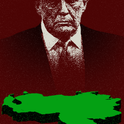
In his visit to Kyiv just before the Russian invasion, French president Emmanuel Macron reportedly suggested that Ukraine might adopt a “Finlandisation” model for its relationship with Russia. In the intervening weeks commentators have periodically returned to the idea, with renewed enthusiasm every time the war escalates. So could such a status form the basis of a political solution to the war?
Finland was for over 100 years part of the Russian empire. It gained its independence in 1917 following the Bolshevik revolution. In 1939 the Soviet Union invaded, established a puppet government and anticipated a rapid military victory which would enable it to occupy the whole country.
Things didn’t turn out that way. The Finns resisted with extraordinary courage and the Winter War dragged on for months. But eventually the numbers told and the Finns had to sue for peace. They gave up around 10 per cent of their territory, including their second-biggest city. When Hitler invaded the Soviet Union in 1941, the Finns retook the land they had lost. In 1944 they had to negotiate again and accept similar terms to the ones which had been forced on them four years earlier.
They also paid a political price. In addition to a peace agreement they signed a friendship treaty with the Soviet Union, with provisions for military consultations which the Soviets used to exercise control not only over Finland’s foreign policy, but also its internal affairs. During the Cold War, Finland was a market economy with a Nordic social model; but books and films to which the Soviet Union might take exception were not published or shown, newspapers were careful in what they printed, and politicians not favoured by the Soviet Union were denied ministerial office. Neutrality was the basis of the country’s foreign policy, but it was a neutrality which permitted no criticism of the USSR. Most Finns today look back on this part of their history with embarrassment. Finlandisation for them is a pejorative term with connotations of subservience and restricted sovereignty.
Such a status is what might be imposed on Ukraine if Russia wins the war. But it is not something which the Ukrainians themselves would rationally choose or which any outsider should recommend. Indeed, the Finns themselves are moving in exactly the opposite direction.
When the Soviet Union collapsed, Finland extracted itself from its previous treaty commitments and joined the EU. It also modernised its armed forces. Finland’s defence policy is based on conscription, which is popular, and on rapid mobilisation. Its army has only 16,000 full-time professional soldiers, but the country has over 900,000 trained reservists, 200,000 of whom can be brought to operational readiness in three weeks. It has a sophisticated airforce currently equipped with F18s, but with F35s on order and large quantities of long-range artillery. Its geography and climate give it a defensive advantage.
What the Finns didn’t do, in contrast to the central and eastern European countries, was to join Nato. There were three reasons for this. Firstly, public opinion was not in favour: until recently less than 50 per cent of the population supported it. Secondly, Finland wanted to preserve as co-operative a relationship with Russia as possible. And thirdly, the Finns have learned from their history not to rely on outsiders for their security: in the Winter War nobody had come to their aid and there were concerns that outsourcing their defence might sap the national will to fight.
The war in Ukraine changed things. Recent polls put Finnish popular support for Nato membership at over 60 per cent, and all the main political parties are moving in favour. The president, Sauli Niinistö, who is responsible for foreign policy, is leading a national debate and preparing the ground with existing Nato members. An application is expected within a couple of months. Sweden will probably follow suit.
Russia has threatened (unspecified) consequences if Finland and Sweden join, but with its armed forces under pressure in Ukraine it is not well placed to take preventative military action. There are things it could do in response, for example by following the example of Belarus and transporting immigrants to the 1,340km-long Finland-Russia border. But there are no ethnic Russians in Finland to incite, and the Finns are pretty good at cyber security. Far from being a drain on Nato’s security resources, Finnish membership will enhance them.
Finlandisation has nothing to offer Ukraine, but there is one thing that it has already learned from Finland’s experience. In 1948 Juho Paasikivi, Finland’s new head of state after the Second World War, remarked that if the Soviet Union wanted to do to Finland what it had done to Czechoslovakia, “they would have to kill half a million Finns, including me.” This is the same message that Volodymyr Zelensky delivers by example every day. The solution to this war will be found on the battlefield, not in any negotiating chamber.











